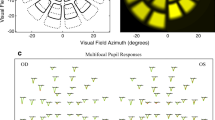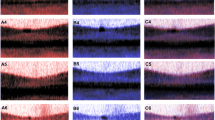Abstract
Purpose
To evaluate the effects of pharmacologically induced mydriasis and miosis on kinetic perimetry findings in normal participants.
Methods
Thirty-eight eyes of 38 healthy young participants underwent kinetic perimetry (Octopus 900 perimeter) with III4e, I4e, I3e, I2e, and I1e stimuli. For each participant, 24 predetermined meridians with 15° intervals were automatically tested with a velocity of 3°/s under normal, mydriatic, and miotic conditions. Mydriasis and miosis were induced by one drop of 0.4 % tropicamide and 2 % pilocarpine hydrochloride, respectively. The isopter area and kinetic sensitivity were compared between the three pupil conditions.
Results
The average pupil size in the normal condition was 5.6 ± 0.9 mm, and it significantly increased to 8.5 ± 0.7 mm after mydriasis (p < 0.01) and decreased to 3.4 ± 0.8 mm after miosis (p < 0.01). Compared to the normal pupil, the isopter area of the dilated pupil was not significantly different under the III4e stimulus; however, it significantly decreased under the I4e, I3e, I2e, and I1e stimuli (p < 0.01). Compared to the normal pupil, the isopter area of the constricted pupil significantly decreased (p < 0.01) with the III4e stimulus and significantly increased with the I3e and I2e stimuli (p < 0.05).
Conclusions
For both pupil conditions, kinetic sensitivity at each meridian showed a similar trend to the isopter area under each stimulus. The isopter area of the dilated pupil generally decreased, whereas the isopter area of the constricted pupil showed various findings. Therefore, careful attention should be paid to changes in the isopter area associated with changes in the pupil size.



Similar content being viewed by others
References
Goldmann H (1945) Grundlagen exakter perimetrie. Ophthalmologica 109:57–70. doi:10.1159/000300224
Trobe JD, Acosta PC, Shuster JJ, Krischer JP (1980) An evaluation of the accuracy of community-based perimetry. Am J Ophthalmol 90:654–660
Weinreb RN, Perlman JP (1986) The effect of refractive correction on automated perimetric thresholds. Am J Ophthalmol 101:706–709
Johnson CA, Keltner JL (1987) Optimal rates of movement for kinetic perimetry. Arch Ophthalmol 105:73–75
Lindenmuth KA, Skuta GL, Rabbani R, Musch DC (1989) Effects of pupillary constriction on automated perimetry in normal eyes. Ophthalmology 96:1298–1301
Kudrna GR, Stanley MA, Remington LA (1995) Pupillary dilation and its effects on automated perimetry results. J Am Optom Assoc 66:675–680
Park HJ, Youn DH (1994) Quantitative analysis of changes of automated perimetric thresholds after pupillary dilation and induced myopia in normal subjects. Korean J Ophthalmol 8:53–60
Mendivil A (1997) Influence of a dilated pupil on the visual field in glaucoma. J Glaucoma 6:217–220
Wood JM, Wild JM, Bullimore MA, Gilmartin B (1988) Factors affecting the normal perimetric profile derived by automated static threshold LED perimetry. I. Pupil size. Ophthalmic Physiol Opt 8:26–31
Herse PR (1992) Factors influencing normal perimetric thresholds obtained using the Humphrey Field Analyzer. Invest Ophthalmol Vis Sci 33:611–617
Edgar DF, Crabb DP, Rudnicka AR, Lawrenson JG, Guttridge NM, O’Brien CJ (1999) Effects of dipivefrin and pilocarpine on pupil diameter, automated perimetry and LogMAR acuity. Graefes Arch Clin Exp Ophthalmol 237:117–124
Webster AR, Luff AJ, Canning CR, Elkington AR (1993) The effect of pilocarpine on the glaucomatous visual field. Br J Ophthalmol 77:721–725
McCluskey DJ, Douglas JP, O’Connor PS, Story K, Ivy LM, Harvey JS (1986) The effect of pilocarpine on the visual field in normals. Ophthalmology 93:843–846
Kee CW, Youn DH (1987) The influence of miotics on the visual field. Korean J Ophthalmol 1:52–58
Hirasawa K, Shoji N, Okada A, Takano K, Tomioka S (2014) Evaluation of stimulus velocity in automated kinetic perimetry in young healthy participants. Vis Res 98:83–88. doi:10.1016/j.visres.2014.03.010
Nowomiejska K, Vonthein R, Paetzold J, Zagorski Z, Kardon R, Schiefer U (2010) Reaction time during semi-automated kinetic perimetry (SKP) in patients with advanced visual field loss. Acta Ophthalmol 88:65–69. doi:10.1111/j.1755-3768.2008.01407.x
Schiefer U, Strasburger H, Becker ST, Vonthein R, Schiller J, Dietrich TJ, Hart W (2001) Reaction time in automated kinetic perimetry: effects of stimulus luminance, eccentricity, and movement direction. Vis Res 41:2157–2164
Wakayama A, Matsumoto C, Ohmure K, Inase M, Shimomura Y (2011) Influence of target size and eccentricity on binocular summation of reaction time in kinetic perimetry. Vis Res 51:174–178. doi:10.1016/j.visres.2010.11.002
Lindenmuth KA, Skuta GL, Rabbani R, Musch DC, Bergstrom TJ (1990) Effects of pupillary dilation on automated perimetry in normal patients. Ophthalmology 97:367–370
Freeman MH, Hull CC, Charman WN (2003) Chapter 15: the eye as an optical instrument. Butterworth Heinemann, Edinburgh
Gerente VM, Biondi AC, Barbosa CP, Lottenberg CL, Paranhos A Jr (2007) Effect of brimonidine tartrate 0.15 % on scotopic pupil: controlled trial. J Ocul Pharmacol Ther 23:476–480. doi:10.1089/jop.2007.0017.R1
Thordsen JE, Bower KS, Warren BB, Stutzman R (2004) Miotic effect of brimonidine tartrate 0.15 % ophthalmic solution in normal eyes. J Cataract Refract Surg 30:1702–1706. doi:10.1016/j.jcrs.2003.12.037
Besada E, Reed K, Najman P, Shechtman D, Hardigan P (2011) Pupillometry study of brimonidine tartrate 0.2 % and apraclonidine 0.5 %. J Clin Pharmacol 51:1690–1695. doi:10.1177/0091270010385932
Kim JM, Park KH, Kim CY, Kim HK, Kim TW, Kim MS (2011) Effects of brimonidine timolol fixed combination therapy on anterior ocular segment configuration. Jpn J Ophthalmol 55:356–361. doi:10.1007/s10384-011-0046-y
Conflict of interest
All authors certify that they have no affiliations with or involvement in any organization or entity with any financial interest, or non-financial interest in the subject matter or materials discussed in this manuscript.
Clinical trial registration
We registered this study with UMIN. (http://www.umin.ac.jp/). ID: UMIN000013248. Date of registration: 2014/02/24.
Author information
Authors and Affiliations
Corresponding author
Rights and permissions
About this article
Cite this article
Hirasawa, K., Shoji, N., Kobashi, C. et al. Effects of mydriasis and miosis on kinetic perimetry findings in normal participants. Graefes Arch Clin Exp Ophthalmol 253, 1341–1346 (2015). https://doi.org/10.1007/s00417-015-3048-5
Received:
Revised:
Accepted:
Published:
Issue Date:
DOI: https://doi.org/10.1007/s00417-015-3048-5




